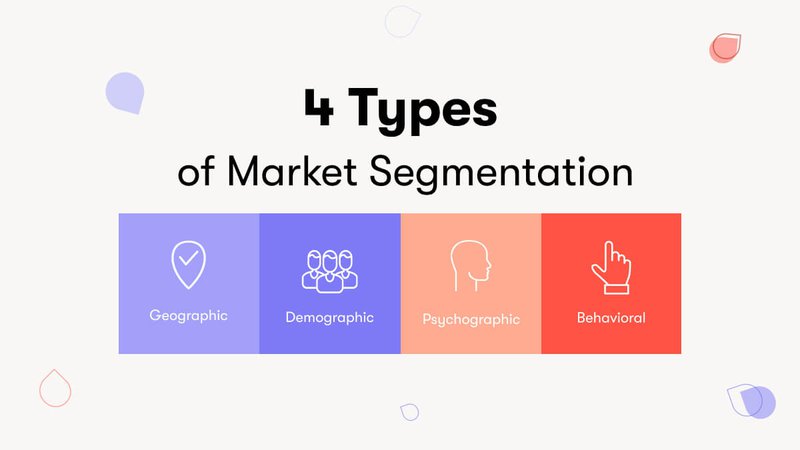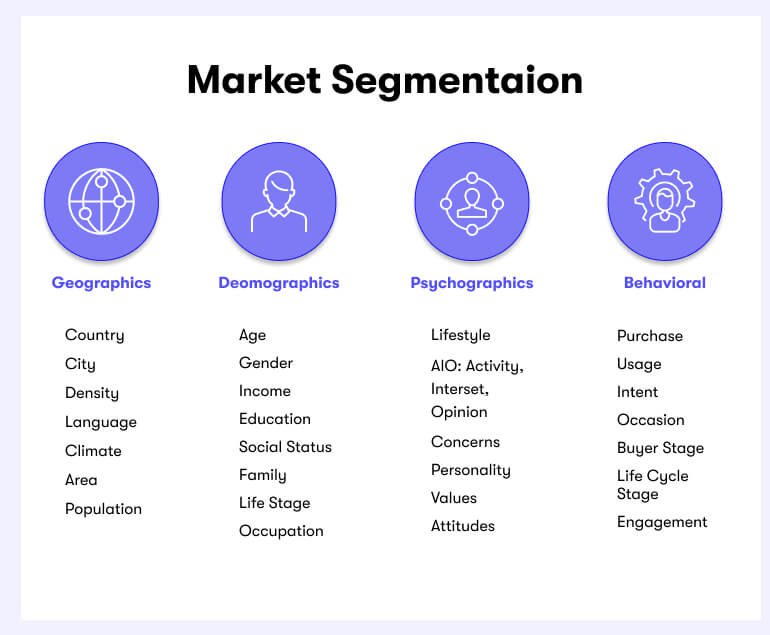The Ultimate Guide to Market Segmentation
Want to improve your product-market fit? You gotta segment your market better. Here's how to use market segmentation as your secret weapon to scale your business.
Updated November 7, 2024

"Don't try to boil the sea" - Peep Laja, CXL
That pretty much sums it up, doesn't it? You can't be everything to everyone.
Companies that try to develop every feature for every type of customer go out of business. Companies that focus on a specific customer segment and zero in all their R&D and marketing efforts on that one type of customer usually win.
Market segmentation has to be an integral part of your digital marketing plan, otherwise, you will go extinct. In this post, we break down what market segmentation is, different types of it, examples, and use cases (Click here to download your free marketing plan template).
Let's begin.
What is market segmentation?
Market segmentation is a marketing strategy where a company identifies groups of consumers and selects specific segments of their target market based on demographics, priorities, common interests, and other psychographic or behavioral criteria.
Why is market segmentation important?
Market segmentation realizes that not all customers have the same interests, purchasing power, or consumer needs. And companies can't cater to all of them and meet everyone's needs. So brands create segments that help them focus their product on specific target audiences and increase the chances of generating sales.
Market segmentation helps companies become more efficient in their marketing and sales campaigns, saves money on unnecessary A/B tests and unused product features, and helps scale the brand much quicker.
Now, there are different types of market segmentation companies can use to their advantage.
Types of market segmentation
There are four main forms of segmentation that brands use:
Demographic segmentation
Demographic segmentation is the process of dividing a market into groups based on age, gender, education, income, and other demographic factors. Demographic segmentation is important because it helps companies to understand the needs of their customers and to develop products that will meet those needs.
Example: a luxury brand should target consumers in a specific income bracket or above a certain income threshold.
Geographic segmentation
Geographic segmentation is the process of dividing a market into different geographic regions. These regions can be countries, states, cities, postal codes, or even neighborhoods. Each region has its own unique characteristics and needs that must be considered when developing products or services for them.
Example: Mcdonald's offers different menu items in different countries in the world. Here is an example of their Maharaja Mac.
Firmographic segmentation
Firmographic segmentation is based on the type of firm. A firm might be a manufacturer, retailer, distributor, or service provider. It's most used by B2B companies and is popularized in what's known as ABM or account-based marketing.
B2B companies often create segments target leads based on their role in a company, the company size, the business size, and the industry.
Behavioral segmentation
Behavioral segmentation is based on how customers behave. This could be user behavior on your site or via any of your marketing channels. It could also include things like:
- if it's for business or personal use
- if the product is purchased online or in-store
- how often the product is purchased
Psychographic segmentation
Psychographic segmentation is a way to divide the market into groups based on a person's values and lifestyle. These segments tend to share attitudes, interests, and values. One example of this would be a political organization that sells products to a specific political party.
Example: a clothing company that creates t-shirts for skaters and skateboarders would segment the market to find 15-25-year-olds who are single, in school, and like to skateboard.
Benefits of market segmentation
There are significant advantages to properly segmenting your market. Studies show that 81% of executives find that segmentation is crucial for growing profits. Here are a few other benefits of segmentation:
1. Targeted digital advertising - you can hyper-target your advertising to each customer segment and increase your click-through rates and sales.
2. Develop effective marketing strategies - focusing on a customer segment helps you select the right tactics and channels to use in your marketing efforts.
3. Create better products - knowing the needs and wants of your target segment can help you with product differentiation and building features that stand out in the marketplace.
4. Identify niche markets - companies often find new segments to target during the segmentation process or new markets to expand to.
5. Increase brand loyalty - focusing on a specific market segment helps you delight your customers better and cater to their needs, which helps decrease your churn.
6. Stay on brand - create better and more focused marketing messages that stay true to your brand voice.
Limitations of market segmentation
How to get started with market segmentation
there are five main steps to the market segmentation process.
1. Define your market
First, look at your market. Is your market big or small? Is there a need for your product or service? And where does your brand fit into the market?
2. Segment your market
Decide on which of the five types of segmentation you want to use (demographic, firmographic, psychographic, geographic, or behavioral). And you can use more than one to create your segment.
3. Understand your market
Conduct some qualitative and quantitative research about the segment that you've chosen. Try to understand who your potential customers are and what their motivation is for buying your product.
4. Create your customer segment
Take your research and create your customer segment(s).
5. Test your marketing strategy
Now take that data and test your findings on your target market. Use analytics tools to test your conversion rates and engagement to see if your segmentation worked.
Now that you know how to create your customer segments let's talk about specific use cases.
How to pick the right segment
According to the Harvard Business Review, there are six main criteria for choosing the right segment to target.
1) Identifiable - you should be able to identify the customers in each segment and distinguish them by their characteristics.
2) Substantial - segment size matters. It's not usually cost-effective to target a segment that's too small for your business. If your potential market segment is too small or doesn't have the buying power to actually purchase your product, try to expand it to other geographic locations, interests, and user behaviors.
3) Accessible - your company should be able to access the segment you chose and it may require building a presence on specific online platforms or marketing channels to do that.
4) Stable - your segment has to be stable long-term to be able to market to it strategically.
5) Differentiable - the people in your segment should have needs that are different than those of other segments.
6) Actionable - you have to be able to provide products or services to your segment. They have to be reachable by your marketing efforts.
Now that you know what to look for in a segment, and how to go about creating it, let's look at some use cases of market segmentation.
Market segmentation use cases
Market research
To grow your business, you need to know who your ideal customer is and where they hang out online. You can use segmentation to break down your research, so you can better understand your customer base.
For example, when you've analyzed a potential new market, you can use your customer insights to identify how your target customers would react to new concepts, offerings, or services. Want to streamline the process? Check out our free market research template.
Segmentation and targeting
Say you're not seeing a high enough ROAS on your advertising campaigns and you want to try to advertise to a new target audience.
If you've gone through the process of market segmentation then you've identified different segments and have defined them by their demographics, needs, priorities, behaviors, or common interests.
You can use this information to improve your paid advertising campaigns, create better marketing messages, and advertise to the ideal audience.
Customer needs research
Sometimes a company has a churn problem where their customers aren't happy with the product or service. This is a great time to step back and do some research about your target segment.
Look at their preferences, and needs, and adjust your product's job to be done accordingly. You may also discover product features that you're missing and ways you can better differentiate yourself from the competition.
Product development
Whether you're developing a brand new product or want to improve your existing offering, doing some market research is a great way to make sure that there's a product-market fit.
"Positioning is the act of designing the company's offering and image to occupy a distinctive place in the minds of the target market" - David Ogilvy, advertising guru
Marketing campaign optimization
Running an omnichannel marketing campaign but not seeing the results you were hoping for? You may need to better segment your market.
Having more information on each customer segment allows brands to personalize their campaigns at scale, and improve their campaign results. It could also help the brand define the right marketing mix of digital channels to better target its segment.
Common segmentation errors
We've talked a lot about what to do, let's talk about what not to do in your segmentation efforts. Here are the top segmentation mistakes brands do.
Making your segment too small
The most common mistake with segmentation is when brands create a segment that's too small. Use the actionable insights from your research to broaden your target market to a size that makes sense for your business.
Not being flexible enough
Audiences change over time and if you see that one segment is not working go back to the larger market and expand it. Test out different characteristics of the broad population and find new variables to filter by.
Prioritizing segment size over everything else
Some brands take a very broad approach to segmentation and focus on creating the biggest segment possible instead of focusing on the buying power of that segment. Make sure you reach out to customers that are able to buy your product.
Leverage the power of segmentation in your marketing campaigns
Seeing good profits with customer segmentation? Don't rest on your laurels. Take the most successful segments and use hyper-personalization to really dig deep and find the specific characteristics that make them the ideal customer.
Then, test out new segments using those variables. And if someone on your team isn't basing their decisions on data, challenge them. Which segment are they targeting with their efforts? And why?
Don't have the resources on your marketing team? Need a hand with segmentation? Come find your ideal marketer at Mayple.








